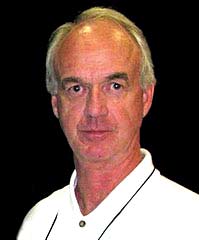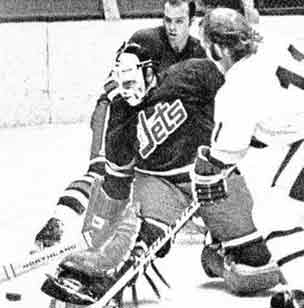

|
V9N8
- Jan. 20 - Feb. 7, 2011:
His first
National Hockey League tryout was with the Los Angeles Kings
in 1971. A year later, he was the No. 3 goalie for the World
Hockey Association’s Winnipeg Jets. For a
kid who started his hockey career at the old Northwood Community
Centre and played Junior A for the Kildonan North Stars, even
being the No. 3 goaltender with the WHA Jets was a dream come
true. “I’d
tried out for the Kings and when I didn’t stick, I went
and played with the St. Boniface Mohawks for a year,”
Tumilson recalled. “Then I got calls from both the Buffalo
Sabres and the Winnipeg Jets. Bill Gibb was the local scout
for Buffalo and they were going to give me a look, but at
the time, the Jets had nobody. Joe Daley and Ernie Wakely
hadn’t even been mentioned yet, let alone signed, so
when Bill Robinson called me from the Jets, I jumped at the
chance. “I
went up against a pretty good goalie named Wayne Dahl, from
Yorkton, and another guy I don’t even remember, but I
won the job. I guess I was cheaper.” Tumilson
stayed for three years as the No. 3 goalie (read: practice
goalie) for the Jets. He played in only three games, during
the 1972-73 season, and finished with an 0-2-0 record with
a goals against average of 5.66 and a save percentage of .846.
Then, as he says, “I went off and got married and had
a real life.” Like most
people, he’s done a lot of things during his life, but
today he’s a successful marketing consultant and sales
executive by day and then, at night, he has become “The
Goalie Whisperer.” Now, in
his 60th year, Tumilson has taken the skills he learned as
a member of the Jets – and a guy who played with two
great goalies, Daley and Wakely, every day – and turned
those lessons into a part-time job, a job he approaches with
the same passion he did when he played. It’s
been said, by many sports experts, that star players don’t
make good coaches and they might be right. Wayne Gretzky was
a terrible NHL coach in Phoenix, baseball Hall of Famer Ted
Williams lost 90 more games than he won as a manager with
Washington and Texas and the great Magic Johnson went 5-11
in 16 games as coach of the L.A. Lakers in 1994. But players
who reached a high level and yet didn’t get to play much
at that level have, quite often, become great coaches. It’s
been said they spent much of their time learning the game.
Coaching stars such as Jim Leyland, Pat Burns, Scotty Bowman,
the late Chuck Daly, were never great players, but they were
all tremendous coaches. “Arnold
Palmer believed that golf was 90-per cent in your head and
just 10 per cent physical ability or skill,” Tumilson
said. “You absolutely have to have the 10 per cent. If
you have no skill, you’re not going anywhere. But a lot
of people have the skill. You have plenty of junior goaltenders.
There are probably 100 goalies in the NHL, if you count it
at three goalies per team. Skill is a given. “But
those guys, playing at the top level of the game, are also
close to the 90 per cent mark when it comes to the mental
part of playing goal. Getting goalies to the 90 per cent level
is what I do.” There are plenty of goaltending schools available to young goalies – good ones, too. But as Tumilson says, “While the assembly-line goalie coaches turn out really good technical goalies, it’s that 90 per cent that these coaches don’t bother with enough.” Tumilson
says he spends most of his time trying to get his goaltenders
to the highest possible level of that 90 per cent category.
“Every
goalie I’ve coached over the past two years is still
playing at the highest level at which they can play,”
Tumilson said. “Every kid who comes to me with is heart
in it, who really wants to live the dream, is still living
the dream.” The young
goalies who come to Tumilson have two advantages: (1) the
experience gained from the level he reached and (2) an older
coach who deals with kids in a quiet, almost dispassionate
manner. He’s as much a friend as he is a coach.
“I
went a long way as a goalie without very much talent,”
he said. “But I spent most of my time playing with the
Jets just trying to figure it out. Everything I did and every
success I had was learned. It wasn’t because I was a
natural or because I was just good at it. As a result, I know
what to tell a kid. I can give him all the answers in a progressive
way.” One of
Tumilson’s star pupils is Eastman Triple A Midget star,
Austin Lotz. Lotz, 15, is considered the best teenaged goaltending
prospect in the province and was ranked as the No. 2 goalie
available in the 2010 Western Hockey League bantam draft by
the Everett Silver Tips. The Everett
Herald wrote: “The Everett Silver Tips didn’t target
goaltending in the draft, but the team believes it got a steal
in seventh rounder Austin Lotz. Lotz, who was the 21st goaltender
taken, was ranked by the Tips as the second-best goalie available.
Lotz, who comes from rural Manitoba, may have slipped under
the radar.” Lotz’s
success makes Tumilson proud. In fact, The Goalie Whisperer
still works with Lotz on a weekly basis. Lotz is a result
of Tumilson’s coaching theory: “STPHF.” “It’s
an acronym for ‘Stop the Puck, Have Fun,’”
Tumilson explained. “It’s great that these kids
are getting better and better because they’re conquering
the mental part of the game, but it also has to be fun for
them. I loved playing goal. I was excited every time I stepped
on the ice. That’s part of what I try to impart on these
kids. I give these kids all the answers in a positive and
progressive way. “I’m
not trying to knock the technical guys. They’re tremendous
coaches. But it’s rare when a coach will spend the amount
of time I spend with a youngster talking about the other 90
per cent of the game. Every kid I’ve coached has moved
on to the next level. I’m quite proud of that.” What makes
Gord Tumilson different from many of the high-end technical
coaches out there is the fact that everything Tumilson teaches
was discovered through his own trial and error, through his
own testing and, in a lesser way, from his own training. Tumilson
didn’t become a professional goalie coach until he was
in his 50s. As a result, he’s spent his life creating
a program that would produce results. So if
you have a grandchild or even a teenager who just so happens
to be a goalie and wants to reach the next level, Gord Tumilson
might be the answer. “We teach a kid everything he needs to know in the first two practices,” Tumilson said. “Then we spend the rest of the year putting the mental and emotional side of the game together. Stop the Puck, Have Fun. It’s a philosophy that I know works. I see it working every day.” (Read
more in the Jan
20 - Feb 7/2011 issue of Senior Scope) Fraud Prevention: Winnipeg, MB:
RCMP Commercial Crime laid charges in relation to Illegal
Lottery Scheme January 13, 2011
|
|
“Frauds
that are based on recruiting an ever-increasing number
of investors. The initial promoters (those at the peak
of the pyramid) recruit investors who are expected to
bring in more investors, who may or may not sell products
or distributorship. Recruiting newcomers is more important
than selling products. No new money is created in pyramid schemes. Investors who get in early take their profits from investors who join later. At some point, no new investors can be found and as a result the last investors, who are at the bottom of the pyramid, lose their money. They also face prosecution, as pyramid schemes are illegal.” - Canadian Anti-Fraud Center |
For additional
information on Pyramids and other scams visit www.antifraudcentre.ca
Cst.
Ben Doiron
Winnipeg RCMP
Commercial Crime Section
(Read more in the Jan 20 - Feb 7/2011 issue of Senior Scope)
|
 |
|
Fred
Douglas Heritage House, centrally located in downtown
Winnipeg.
|
Heritage
House is staffed with Tenant Companions twenty-four
hours a day, seven days a week. Ninety-five percent
of our Tenant Companions are Certified Health Care Aides,
and provide assistance to help seniors maintain their
independence. For example: medication reminders, shower
assist, cueing for ADLs (activities of daily living),
3 nutritious meals plus 2 snacks each day – prepared
on-site with a home-cooked feel, weekly laundry and
housekeeping service, and a host of other daily activities.
Our Tenant Companions are like those "great neighbors
and friends you can always count on." Heritage
House staff enjoys working here and it shows in the
warm happy atmosphere our tenants call "home."
We offer a tailor-made service plan for each tenant.
If nursing care is required, Home Care will provide,
and house-call doctors are only a phone call away!
Food
is an important part of our lives. At Heritage House,
we take this to heart! Our in-house chefs prepare three
hearty, nutritious meals on-site, and you’ll enjoy
these served by our multi-tasking Tenant Companions
in our central dining room, along with a mid-afternoon
and evening snack. We design a dietary profile for each
Heritage House tenant, taking into consideration your
needs, likes and dislikes.
 |
|
Suites
at Heritage House are the largest of all Supportive
Housing sites in Winnipeg.
|
Heritage
House has 28 one-bedroom suites ranging in size from
500 to 730 ft2. We are proud to say that of all the
supportive housing sites in Winnipeg, our suites are
the largest! Suites are also large enough to accommodate
couples. In a couple’s scenario, both can qualify
for supportive housing, or one person may need the extra
supports that come with Supportive Housing, and their
spouse can live in the same suite paying just the service
package. All suites are wheelchair accessible. Each
suite has its own temperature control for heat and air
conditioning. You can keep the temperature as warm or
as cool as you like! Suites have lots of windows, and
each window can open, if desired, to allow fresh air
on a breezy summer day. Each suite comes with an emergency
pull cord in every bathroom and bedroom, and its own
"tea and toast kitchenette" complete with
microwave and full-size fridge with a freezer on top
for those all-important midnight ice cream snacks! Suites
are spacious enough that the look and feel of your previous
home can be re-created to make it feel like "home."
All personal laundry, linens and towels, and housekeeping
are done weekly, and you’ll never have to vacuum
again! As well as having all meals prepared… it
doesn’t get much better than this!!!
Various
activities and exercise programs are scheduled throughout
the week, and you can partake in as many or as few as
you like. You can also choose just to sit in the sunny
atrium area, enjoying the sunshine and listening to
our pet Cockatiels… isn't life grand! A full-service
hairdresser visits Heritage House once a week, and our
Spiritual Care Coordinator (chaplain) leads an ecumenical
worship service, followed by refreshments, conversation
and visiting every Tuesday afternoon.
Centrally
located in downtown Winnipeg, Heritage House is within
walking distance to major medical facilities. Family
members who work downtown can stop by for a quick visit
at lunch or after work. Through skywalks, you can access
many downtown destinations without having to step outside
– a welcome feature especially when it’s -36°C
outside! Wheelchairs are available for family members
wishing to escort you on shopping excursions, if walking
a distance presents an obstacle.
How
do you or your loved one qualify to be able to live
in such a fantastic establishment? Call today and find
out! Our Site Supervisor, Shauna Gladish, is happy to
answer any questions, and provide information as to
criteria for living in Supportive Housing (telephone
– 949.9027, e-mail – sgladish@fdl.mb.ca).
Perhaps you’d like to arrange for a tour, and see for yourself what a wonderful place Heritage House is to live!
(Read more in the Jan 20 - Feb 7/2011 issue of Senior Scope)
Financial Planning:
Should I contribute to an RRSP, a TFSA or both?
BRIAN G. KONRAD CFP, Financial Consultant
The introduction
of the Tax-Free Savings Account (TFSA) represents the most
important change to the way Canadians save money since RRSPs
were launched in the late ‘50s. But the big question
on many people’s minds is whether they should contribute
to a TFSA, the tried-and tested RRSP or possibly even both?
Before
shedding some light on their question, let’s first get
a firm grasp on some of the innate differences and similarities.
First and foremost, both RRSPs and TFSAs provide investors
with the opportunity of tax-sheltered compound growth for
investments held inside each plan. But unlike an RRSP, contributions
to a TFSA are not tax deductible, amounts can be withdrawn
tax free at any time and withdrawn amounts are added back
into your TFSA contribution room the following year.
Now that
we’ve established their unique characteristics, let’s
get back to our original question:
Which
is best?
On a very basic level, looking at your pre-retirement and expected post-retirement marginal tax rates can provide you with an idea how to best allocate your investments. If you expect to be in a lower tax bracket during retirement, contribute to an RRSP is generally more beneficial. However if in retirement you anticipate being in a tax bracket that is equal or higher than your pre-retirement tax rate, the TFSA may be more tax-efficient.
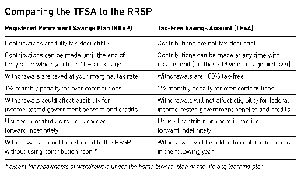
Click on image for larger
chart
Hold
on; not so fast.
Although
it’s tempting to settle on a simple rule-of-thumb, the
decision on whether you should use a TFSA or RRSP is not that
simple – your advisor needs to work with you to consider
the entire spectrum of financial strategies at your disposal
that could ultimately impact your approach.
Even if
you anticipate having a lower marginal tax rate in retirement,
maximizing your RRSP contributions may not always be the most
tax-efficient long-term strategy. Since RRSP withdrawals (directly
or through your Registered Retirement Income Fund (RRIF) or
an annuity) increase your taxable income, those withdrawals
may affect certain government income-tested benefits and credits
such as the Old Age Security benefit and the Age Credit.
On the
other hand, if your expected marginal tax rate in
retirement is equal or higher than during your accumulation
years, contributing to your TFSA may not be the best approach
either. For example, RRSPs that are converted to a RRIF or
an annuity after age 65 can produce income that is eligible
for the pension income tax credit, and thus qualifies for
pension income splitting with your spouse. Other income splitting
strategies such as the use of spousal RRSPs could effectively
distribute a portion of your taxable income to a spouse with
a lower marginal tax rate in retirement, further reducing
your tax bill and reducing the claw-back effect on your income-tested
benefits and credits.
So
where does this leave us?
Generally
speaking, a TFSA may be better suited for shorter-term goals,
such as an emergency fund or saving for a major purchase,
since there is no tax on withdrawals and these plan withdrawals
are added back into your TFSA contribution room the following
year. However, for long-term objectives, RRSPs are generally
the vehicle of choice since there are strong incentives to
keep your money invested, in the form of taxes and lost contribution
room on the withdrawals from an RRSP. The TFSA can also be
a powerful retirement savings tool. However due to the ease
with which TFSA savings can be accessed (no taxes on withdrawals
or loss of contribution room) only a disciplined investor
who can resist the temptation to dip into their savings prior
to retirement will fully benefit from its potential as a source
of retirement income.
Remember,
there is no one-size-fits-all solution. In fact, there is
amultitude of variables that must be taken into consideration.
In many cases, the TFSA should be used
as a complementary product, along with your RRSPs, as they
both have their own advantages. Your personal savings strategy
needs to take into account your unique circumstances as well
as your short and long-term objectives.
To discover
which approach is best for you, contact your Investors Group
Consultant.
__________________________________
BRIAN
G. KONRAD CFP
Financial Consultant
brian.konrad@investorsgroup.com
(204) 489-4640 ext. 246
100-1345 WAVERLEY STREET
WINNIPEG, MB R3T 5Y6
1-888-205-4828
Written
and published by Investors Group as a general source of information
only. It is not intended as a solicitation to buy or sell
specific investments, nor is it intended to provide tax, legal
or investment advice. Readers should seek advice on their
specific circumstances from an Investors Group Consultant.
Commissions, fees and expenses may be associated with mutual
fund investments. Read the prospectus before investing. Mutual
funds are not guaranteed, values change frequently and past
performance may not be repeated.
™Trademark
owned by IGM Financial Inc. and licensed to its subsidiary
corporations.
“Should I contribute to an RRSP, a TFSA or both?” ©2010 Investors Group Inc. (03/2010) MP1492
(Read
more in the Jan
20 - Feb 7/2011 issue of Senior Scope)
Recreation in Winnipeg, Manitoba:
Lots To Do Even with Snow on the Ground
 By
Scott Taylor
By
Scott Taylor
Helene
Dobel has every right to
be proud of her accomplishment.
The 86-year-old Winnipegger, who loves nothing more than spending
time on a great cruise ship, is now the proud holder of a
Norwegian Cruise Lines record.
“On
my last cruise (on the Norwegian Pearl) I was he oldest person
ever to go down the water slide (she was 85 at the time),”
said Dobel proudly. “They even made an announcement on
the ship. I’m in great shape.”
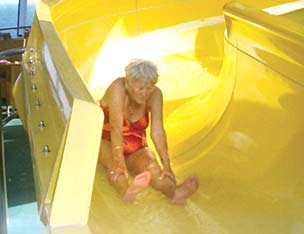 |
|
Helene
Dobel on a cruiseship waterslide.
|
Dobel
is in great shape because she’s one of dozens of seniors
who get up every day and work out in the gym. It’s not
always easy and there are days when it’s not always fun,
but it’s helped give Dobel and a number of other octogenarians
in Winnipeg a long, happy and active life.
We’re
fortunate in Winnipeg. There are all sorts of tremendous gyms,
many within walking distance of your home — Shapes, Good
Life Fitness, Curves, the Re-Fit Centre, the Rady Centre and
of course the YMCA. Every day, hundreds of seniors descend
on these gyms to stay toned, balanced and strong.
Dobel,
however, is a member at what I call “My gym:” the
Assiniboine Athletic Club at Fort Garry Place in downtown
Winnipeg. This gym is a haven for seniors and among the proud
members are Earl Fast, 89, and Romeo Manaigre, 86. They’re
in the gym, early in the morning, every single day.
“I
would say that we’re very senior friendly,” said
Neil Dalrymple, 50, the gym’s long-time manager. “We
have members that range from their 50s all the way up to 90.
I just think they find it comfortable.”
Assiniboine
Athletic Club is the home of Manitoba’s Masters bodybuilding
champion, 65-year-old Tom Heffner, but it’s also the
home of retirees and seniors such as Ken Collins, Terry Johnston,
June Wiebe, Valentina Wilson (who is nearly 70 and still does
three sets of a dozen pull-ups every day) and Pastor Bruce
Miles.
It doesn’t
hurt that the music that’s played through the gym’s
sound system comes directly from the new FAB 94.3 a local
station that plays music that is 40-50 years old and Dalrymple,
himself, who has “been here forever,” is well-known
to all of his members. That’s why, for seniors, it’s
a pleasant, friendly place, in a city where many gyms are
full of 20-something stick-figure women and huge, strutting
muscular men.
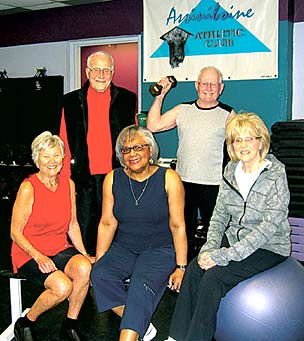 |
|
L-R:
Back Row: Earl Fast (89), Romeo Manaigre (86). Front
Row: Helene Dobel (86, but at 85 pictured as the oldest
person to go down the 3 story waterslide on the Norwegian
Pearl), Valentina Wilson, Helen Yakiwchuk.
|
“I
think it’s the comfort level we provide that encourages
our seniors to come back every day,” said Dalrymple,
who always jumps to provide advice when a member has a problem
with a fitness machine or the free weights. “We’re
a small gym and we don’t provide any group activities
for seniors, but many of our members have been here for a
long time because there is no pressure and they can do whatever
they like to stay fit. It’s pretty obvious that we don’t
care if you’re big or small or old or young. We only
care about you and the fact you want to stay fit.”
It’s
been said that you’re never too old to learn something
new. We all know it’s true.
But here’s
an adage that can be proven, too: You’re never too old
to get in shape and stay active.
Winter
is upon us and that means if you aren’t getting up early
to walk around the mall, you’d better find another way
to stay active. Heading off to the gym every morning is one
way to get in shape, but not every one is comfortable with
the big machines, free weights and the stick-figure 20-somethings.
However,
that doesn’t mean you just say, “I can’t be
bothered.” There are plenty of fun ways to get in shape,
often at no cost, no matter your age.
Like ice
skating? Did you know that you can skate every day of the
week inside a Winnipeg Arena for free? It’s true. On
Sunday, you can skate at the Billy Mosienko Arena on Keewatin
from 3:30 to 4:30. You can skate Monday from 11 a.m. to Noon
at the St. James Civic Centre; on Tuesday at the Bertrand
Arena in St. Boniface from 6:45 p.m. to 7:45 p.m.; Wednesday
at the Eric Coy Arena on Oakdale Dr. from 6:45 p.m. to 7:45
p.m.; on Thursday at the Maginot Arena from 6:30 p.m. to 7:30
p.m., on Friday at the River East Arena from 5:45 p.m. to
6:45 p.m. and on Saturday at the Terry Sawchuk Arena on Kimberly
Ave., from 11:45 a.m. to 12:45 a.m. Just visit www.winnipeg.ca
for the entire free skating schedule at more than 13 arenas
in Winnipeg.
If you’d
prefer dancing, and you’ve definitely decided not to
go to a gym for a dance-aerobics class, there are plenty of
great opportunities in Winnipeg for not a lot of money. You
can take a 10-week line dancing course at the St. James Civic
Centre ($52), you can join Zumba gold, a dance fitness program
designed for seniors at either the Cindy Klassen Rec. Centre
on Sargent, the Elmwood/EK Seniors Centre on Poplar, the Fort
Rouge Leisure Centre on Osborne or the Pan Am Pool at 25 Poseidon
Bay, depending on the day or the region of the city that’s
most convenient ($57).
Speaking
of the Pan Am Pool, you can swim at any one of 12 pools (including
the Pan Am Pool) or three city-operated leisure centres every
single day or evening of the week. A 30-visit pass is $153.00
while a full three-month pass costs $137.00. Swimming is a
wonderful way to stay toned and strong without all the wear
and tear on your joints, bones and muscles.
There
are so many places in Winnipeg to get fit, be active and feel
healthy that it’s almost impossible to list them all
here. Quickly, here are 10 ways to feel good about yourself
this winter and spring:
1. Go
bowling: Just get on your personal computer and google “Bowling
alleys in Winnipeg.” It’s incredible. You’ll
come with a list of more than two dozen alleys around the
Capital Region. Bowling, five- or 10-pin, is a great way to
get together with friends, socialize and have a little workout
all at the same time.
2. Aqua-fitness:
For those who are aging this is the perfect way to get some
cardio-vascular and muscle-toning exercise without beating
up your joints. Bonivital Pool and Sherbrook Pool both have
Aqua-fitness programs that will cost about $60 for a 10-week
program.
3. Pilates:
a system of exercise where smooth motions and proper breathing
will tone and lengthen your muscles. For $75 you can get involved
at half-a-dozen pools, arenas or leisure centres in Winnipeg.
4. Cardio-fitness:
the city has a 10 week cardio-fitness program for those over
the age of 50 (it began last week but I’m told you can
still register) at the St. James Civic Centre. It’s just
$31 to join up.
5. Body
toning: This is a flexibility class and we all know that flexibility
is one of the first things to go. It’s held at the Elmwood/EK
Seniors Centre and the Greendell Park Community Centre. A
10-week program costs $44.
6. Aerobic
fitness: Improve your cardio at the St. James Civic Centre
for 10 weeks and just $44. You can use your Active Living
Passes to drop in on these classes.
7. Sing:
You can sing at the Glee Club at Fort Rouge Leisure Centre
at 625 Osborne St. every Wednesday morning at 9:30 a.m.
8. Play
Badminton: You loved it in high school. Why did you quit?
The Greendell Seniors 55-Plus Badminton players meet every
Monday and Thursday from 12:45-2:45 p.m. and on Wednesday
from 9-10:45 a.m. at the Greendell Park Community Centre,
75 Woodlawn Ave. Call them at 253-9112 if you have
any questions. Meanwhile, the Glenwood Community Club Seniors
also have a badminton program on Tuesdays and Thursdays. Just
call Ray at 253-2542.
9. Yoga:
There is a yearly drop-in yoga class at St. James Assiniboia
Centennial Pool on Parkdale. Yoga is perfect for older, active
adults who want to maintain flexibility, balance and range
of motion.
10. Basketball
and volleyball: If you want to work on your game, join a team
or meet people who just like to play, head straight to the
Winnipeg’s Central YMCA. Monday to Friday from Noon to
1 p.m. it’s open basketball at the Y’s big gym and
if you want to play volleyball try Wednesday nights between
8-10. Who knows, you might find some folks who’d like
you to play on their team.
There
is no excuse for any healthy senior in the Capital Region
to find a place to stay active, keep fit and be healthy. In
fact, there are so many recreational programs in this part
of Canada, that you couldn’t possibly do it all.
So get up, get out and get active. Just ask my 86-year-old friend Helena at Assiniboine Athletic Club. You could be the next octogenarian zooming down the water-slide on your next cruise.
(Read more in the Jan 20 - Feb 7/2011 issue of Senior Scope)
Travel feature - Walt Disney World:
Disney is Even Better Without the Grand Children
By Scott and
Sally Taylor
LAKE
BUENA VISTA, Fla. – So you’ve been to Florida’s
Walt Disney World with the kids and the grand kids and you
loved it. You loved it because it was fun and because there
is nothing better on this earth than seeing your grand kids
with great big smiles on their faces.
Well,
fellow 60-plussers, guess what? A trip to Walt Disney World
(WDW) can be a lot more fun without the kids. Honestly. There
is no better place on the planet to take a vacation for so
many reasons. In fact, there are so many great reasons to
go to WDW that there isn’t enough space here in Senior
Scope to list them all.
But, just
for chuckles, let’s start with safe, convenient and economical.
For older couples, a Disney vacation is a great vacation.
Now, in
the time-honored tradition of full disclosure, we are Disney
regulars. In fact, we are annual passholders. We’ve often
considered taking vacations at more “adult” resorts
or in big American cities (and yes, we love Washington, D.C.,
Boston, Phoenix, Seattle, Las Vegas, Los Angeles and Chicago),
but after adding up the cost and the effort, we, more often
than not, return to WDW. We love the weather, the location,
the safety, the service and, most of all, the price.
Contrary
to popular belief, a Disney vacation is not expensive. In
fact, as a sportswriter, when I go south to cover the NHL,
the NFL, the NBA, and Major League Baseball, I stay at a Disney
resort for two important reasons: (1) the location, just west
of Orlando on Inter-State Hwy. 4 gives me instant access to
nine major league sports franchises all within 30 minutes-to-four
hours by car (plus all those spring training baseball games
in March) and (2) because Disney is so economical.
It’s
also safe. When we go to WDW, I can leave the hotel at 4 p.m.
to head off to a Lightning game in Tampa or a Magic game in
downtown Orlando, and Sally can go off on a Disney bus and
do anything she pleases, all by herself. In fact, many of
her favorite moments at Disney have happened when she’s
alone at Epcot or Animal Kingdom or Downtown Disney and she
doesn’t have a husband to drag around.
In recent
years, it’s become extremely easy to get to WDW now that
WestJet has a direct flight and, take our word for it, it’s
a great flight. Of course, you can always use your airline
points or Air Miles and make one easy stop along the way.
When you
reach Orlando International you are arriving at one of the
world’s great airports. Just listen to the flight attendant’s
instructions and follow the signs and we guarantee, you can’t
miss your baggage claim or your ground transportation and
when you return to the airport to head home, there are plenty
of places to eat and relax before you catch your flight.
During
the recent winter baseball meetings at Walt Disney World,
I was talking to my old friend, Buck Martinez, the Toronto
Blue Jays play-by-play announcer. Buck lives near the beach
in Sarasota, Fla., but during our conversation, he said, “I
was thinking why so many people were moving to the Orlando
area and it’s pretty simple really: No taxes, plenty
to do, great weather and the best airport in the country.”
He’s right about that.
If you
have no plans to rent a car (we always do and we rent from
Alamo because of the convenience of having a number of outlets
on Disney property), you have two options. (1) You can wait
and take Disney’s Magical Express. It will pick you up
at the airport and drive you to your Disney Resort for free.
It could take some time, but you’ll save $70. (2) If
you aren’t staying on Disney property or if you’re
just in a hurry to get settled into your resort, a taxi ride
is anywhere from $60-$80 depending on where you’re staying.
Disney
resorts come in three price categories: value, moderate or
deluxe. We love the deluxe rooms, but when you stop and think
about it, if you’re really planning on enjoying your
Disney experience, you aren’t going to spend all that
much time in your room, so why spend all the dough. We usually
choose the moderate resorts, but have had some great times
at the value resort, Pop Century.
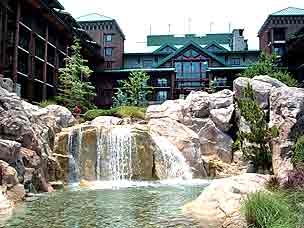 |
|
The
Waterfall at Wilderness Lodge Resort.
|
Of course,
if you haven’t taken your grand kids to the parks and
if you’re going as first-timers, your initial question
is: What do we do once we’ve arrived? Fear not, you have
an abundance of choices.
In fact,
you probably have three days of choices without even going
to a theme park. There is shopping, eating, a great movie
theatre and of course Cirque de Soleil’s magnificent
La Nouba, all at Downtown Disney. You could play four sensational
18-hole golf courses (our favorite is Lake Buena Vista) or
you can walk nine holes at Oak Trail and that’s always
fun – and cheap, too.
 |
|
Fulton’s
Crab House at Downtown Disney.
|
If you’re
staying at a moderate or value resort, get on the monorail
(it counts as a ride) and head over to a deluxe resort and
just hang out. If we’re staying at Pop Century, we often
go over to the Grand Floridian for a swim and a meal. And
if you have some disposable cash and a few extra friends,
book a fireworks cruise. It’s the best way to watch Wishes
at the Magic Kingdom or Illuminations at Epcot. Or grab a
spot on the beach at the Polynesian Resort and watch Wishes
from across the lake. It’s relaxing and very entertaining.
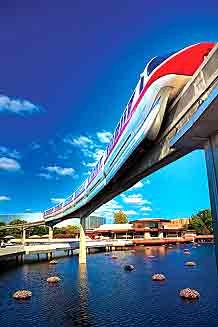 |
|
Walt
Disney World Monorail.
|
However,
let’s assume you’re going to WDW to take in the
theme parks. You’ve purchased your Hopper Pass, the pass
that allows you to go to all four parks on an unlimited basis,
and you’re ready to take on the crowds. Let’s take
an adult look at the four parks (we love thrill rides, but
for this piece, we’ll leave the thrill rides to the kids):
Hollywood
Studios
Hollywood
Studios is filled with attractions and shows: the Indiana
Jones Epic Stunt Spectacular, the 33-minute Lights, Motors
Action Extreme Stunt Show, the live stage show of Beauty and
the Beast and then, at night, Fantasmic.
It’s
a fun theme park to walk (especially at Christmas time) but
we usually don’t eat here. Instead, we’ll take the
two-kilometer walk to Epcot, where you’ll find our favorite
park, the one where we eat, drink and, to be frank, spend
most of our time.
Epcot
We love
Epcot. It’s the adults park. We love walking the 2.4-kilometre
circle that’s called the World Showcase. We spend more
time eating at this park than we do eating at Florida restaurants.
That’s probably because we eat on the go and we seldom
sit down to eat. It just takes too much time.
 |
|
Epcot
Theme Park.
|
Our favorite
snack-and-go spots are the new La Cantina de San Angel (Mexico),
the Lotus Blossom Café (China), the Yakitori House
(Japan), the Boulangerie Patisserie (France) and the Yorkshire
County Fish Shop (United Kingdom).
We also
have two favorite times of the year to be at Epcot: From March
2-May 15, 2011, for the Flower and Garden Festival and from
Sept. 30-Nov. 13, 2011 for the annual Food and Wine Festival.
The Food and Wine Festival is always a highlight of any year.
We tend
to justify what we eat by how much we walk.
Animal
Kingdom
Animal
Kingdom has the best thrill ride at all the parks, Expedition
Everest, but we’re not here to stand in line
waiting to lose our lunch.
Animal
Kingdom is loaded with some tremendous attractions (Kilimanjaro
Safaris), walking trails (the Pangani Forest Exploration Trail,
Maharajah Jungle Trek and Rafiki’s Planet Watch), shows
(Finding Nemo – the Musical and Festival of the Lion
King) and the daily parade (Mickey’s Jammin’ Jungle
Parade).
When it
comes to food, it’s not our favorite park, but we enjoy
snacks at the Yak and Yeti Counter Service or at Pizzafari
and there is nothing better than watching people while enjoying
a cold beverage at the Dawa Bar (we suggest an ice cold Safari
Amber).
The
Magic Kingdom
You can’t
escape children or families here and we find that everyone
is a child at the Magic Kingdom (remember, there are no adult
beverages served here), but if you want to stick to your “adult”
schedule, how about avoiding the park and spending a day enjoying
the Magic Kingdom Resorts?
The Grand
Floridian, the Contemporary and the Polynesian are all on
the monorail line that passes through the Magic Kingdom, so
visit the resorts, enjoy a meal, stop in at a bar, take a
dip (They do frown upon it, but who’ll ever know?). You
can get off the monorail and take a boat from the Grand Floridian
to the Polynesian and back to the front gate of the Kingdom.
You can walk from the Kingdom to the Contemporary and stop
in at the Wave for a drink. Take a walk from the Polynesian
to the Grand Floridian and stop in at Mizner’s Lounge
(open from 5 p.m. to midnight) for a little jazz, a beverage
and a snack.
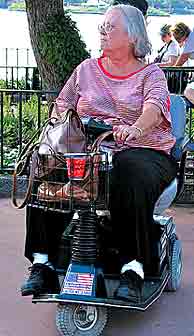 |
|
It’s
scooter world at Epcot.
|
There
is so much to do at WDW without spending time at a theme park
and without spending a lot of money. In fact, you can always
save the cost of a couple of theme park tickets and use the
money to see La Nouba, take a fireworks cruise, play some
golf (mini-golf, as well) rent a boat and go fishing on Bay
Lake or spend time in a spa.
Always
remember this: At Walt Disney World, you’re never too
young and you’re never too old and that means there is
always something to do without the grand kids.
(Note: If you’re looking for travel packages, we recommend WestJet Vacations or CAA. If you’d like that personal touch in Winnipeg, we recommend calling Constance Torossi at Enchanted Dreams Travel Company which specializes in Disney vacations, at 204-229-0296, connie@enchanteddreamstravel.com, www.enchanteddreamstravel.com)
(Read more in the Jan 20 - Feb 7/2011 issue of Senior Scope)
Backyard Birding 101
 By
Sherrie Versluis,
By
Sherrie Versluis,
Owner of The Preferred Perch Wild Bird Specialty
& Gift Store
Growing up, I was
lucky enough to be able to spend my summers in the great outdoors
of Lake of the Woods. It was there that my love of nature
flourished into what has literally become my livelihood. The
smell of the fresh green forest filled with the sights and
sounds of wild birds turned me into a true nature nut. The
birds left an impression that has not only stayed with me
but become my job. It has now been over 15 years that my business,
The Preferred Perch Wild Bird Specialty & Gift
Store, has been in operation. It has been nothing
short of an honour to introduce people to the 2nd biggest
hobby in North America, attracting and feeding wild birds
in your own backyard.
Many people who
start feeding wild birds usually begin with a basic wooden
feeder and wild bird mix. Unfortunately this usually results
in seed spilled all over the ground and nothing more than
masses of House sparrows visiting. House sparrows are the
‘bad guys’ of backyard birding. They not only make
a mess but they dominate feeders and intimidate songbirds
people want to see. House sparrows are an introduced species
that has learned to adapt to life here and they do whatever
it takes to succeed. Besides dominating feeders, House sparrows
will break the eggs and even kill the chicks of our native
birds that may be nesting in ‘their‚ territory’.
It is important to try to not attract House sparrows to your
feeders but sometimes it’s not possible. They tend to
live in cedar trees and shrubs so if you have such housing
it is unlikely they will ever go away no matter what you do.
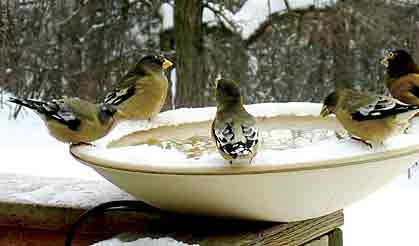 |
|
Evening
grosbeaks at a heated birdbath.
|
House sparrows
are attracted to the seed white millet in wild bird mixes.
That is why you will see them throwing seed everywhere, they
are digging for what they want. To attract other birds, it
is a good idea to give sparrows their own feeder at the back
of the yard filled with pure white millet. Closer to your
home where you can see best, place a good quality sunflower
feeder filled with Black oil sunflower. This will attract
Black-capped chickadees, nuthatches, bluejays, and finches
to name a few. These birds can be found in Winnipeg and surrounding
areas throughout the entire year. A good choice for a sunflower
feeder is called a Tube Feeder. These are tall cylindrical
feeders that have feeding ports from top to bottom with perches
attached. This design reduces waste significantly and you
don’t have to fill the feeder so often. Trays are available
separately to attach to the bottom which helps in keeping
the ground free of shells but it also encourages other species
that are too large to land on the perches.
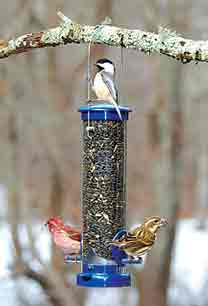 |
|
A
Black-capped chickadee along with a pair of Purple finches
eating from a sunflower feeder.
|
Feeding wild birds
is a hobby that is known to reduce stress as watching the
antics of bird behaviour can free your mind of negative thoughts.
It is also very beneficial to those who may be homebound as
it provides an easy and pleasurable source of entertainment.
To me, it is rewarding in so many ways but especially when
I hear from others how feeding wild birds has become a way
of life for them and their family. Bring nature into your
life and just feed the birds! Happy birding!
The Preferred
Perch Wild Bird Specialty & Gift Store
Open 7 days a week.
Call 25-PERCH (257-3724)
1604
St. Mary's Rd • Winnipeg
(Read more in the Jan 20 - Feb 7/2011 issue of Senior Scope)
HUMOUR
COLUMN:
MADS - Men Against Drunk Shopping
 By
Willian J. Thomas
By
Willian J. Thomas
Humour Columnist
It’s
the little things that tell the big story. Like that image
of a little old lady on a corner waiting for a Good Samaritan
to help her across the street. Well soon there will be a dozen
elderly ladies on that corner kicking each other in the shins
over who’s first in line and the Good Samaritan, a.k.a
the government, will be a “no show.”
That lovely
scene of two men playing checkers in the park. Soon there
will be more checkerboards than benches in that park because
the world’s population is aging at an accelerated rate
never seen before in history. The number of older people is
increasing much faster than the number of young people. The
Golden Girls are cancelling Sesame Street.
The elderly
used to worry about being a burden to their families, now
they’re about to become a big problem for the planet.
By 2018, 65-year-olds will outnumber those under the age of
5 for the first time ever.
This will
also turn the global economy on its’ head. Experts believe
that maintaining a decent standard of living for the old will
place a crushing financial burden on the young.
Next year
the first wave of baby boomers in the United States will be
eligible for full Social Security and Medicare benefits setting
off a two-decade, astronomical spending spree by a government
that’s already in mile-high debt. So Sarah Palin’s
insane claim that President Obama’s healthcare plan called
for “euthanizing the elderly” is starting to look
like a viable option somewhere down the line.
By the
year 2050 there will be 300 million people over the age of
65 in China and not nearly enough toothpicks to go around.
The Chinese government is passing the buck to the families.
They have a name for it: “the 4-2-1 problem.” That’s
one child caring for two parents and four grandparents. Not
too much pressure on a young Kemei, circling help-wanted ads
in the Shenzhen Times while riding around on a bike with a
flat front tire.
To man
their massive factories the Chinese government is flooding
the biggest cities with young people and driving the old out
of their homes. It’s called “age apartheid.”
All of
this information is covered by the Global Again Preparedness
Index compiled by a Washington think tank and when it comes
to today’s forecast and tomorrow’s crisis –
you couldn’t do better than the acronym GAP.
But what
will Canada do? The government of Canada, unlike those of
many unprepared countries has some concrete plans in place.
First, when ‘Elderquake’ hits home hard over the
next twenty years, our government plans to act really, really
surprised.
They plan
to blame Stats Canada and a software program short on zeros.
While claiming to have made provisions for the health and
financial well-being of 1.5 million elderly, they will claim
to have no idea the real number was 15 million.
“We’re
mad as hell,” the Prime Minister will say. But not as
mad as the ninety-year-olds living in their grandson’s
garage.
They will
blame the failure of the system on the previous government,
who will in turn blame it on their predecessors who will blame
it on Paul Martin. Walking through Lafontaine Park in his
undershorts, Paul Martin will say: “I can’t recall.”
Then the
photo ops will begin showing that the crisis is not nearly
as bad as the experts claim and the elderly of Canada, now
living in an abandoned airport north of Toronto are receiving
water, ration packs left over from Afghanistan and warm socks.
It’s called “warehousing.”
Those
requiring serious medical attention will be offered “Varadero,
one week, all-inclusive, air, hotel, meals, bar drinks and
hospital transfers.”
The federal
health minister, later to be reprimanded for it, will characterize
the elderly as “lazy and unproductive” pointing
out that “Hey, why don’t they try their luck at
the casinos!”
Health
Canada posters and billboards will spring up extolling the
virtues of the “aging initiative” showing a photo
of 94-year-old Mable Spark who won ten dollars at her nursing
home for guessing the number of jelly beans in a canning jar.
“And,” the ad will say, “she also got to keep
the jelly beans.”
A spry
95-year-old Julie Andrews will appear in a feel-good video
extolling a few of her favorite things like: “Air bags
on walkers and seatbelts on rockers.”
The minister
of consumer affairs will almost lose his post for buying millions
of cheap canes from China made of rubber. The recall will
be ugly but not without comical incidents.
In a Hail
Mary move to save its skin, the government will come up with
its own “4-2-1 formula.” That’s one care giver
for every two rooms full of elderly with four minutes maximum
in the bathroom, each. Do you get the feeling this government
believes that this trend too will pass?
Oh, and the real bad news? We’re all healthier than our parents and on track to live a lot longer.
For comments, ideas or a signed copy of
The True Story of Wainfleet,
go to www.williamthomas.ca
(Read more in the Jan 20 - Feb 7/2011 issue of Senior Scope)
FOR THE HEALTH OF IT:
Getting the Sugar OUT of your Diet
By Steven Denault
So now
that we know how and why sugar is creating an epidemic of
illnesses let’s talk about what we should be doing about
it.
Refined
and synthetic sweeteners are used extensively by processed
food manufactures. The main reason they include sweeteners
is to give the product some taste and of course it’s
a cheap filler.
As consumers
we have come to think of sugar as a comfort food, we expect
and desire it. In fact the majority of us have become addicted
to sugar and sweeteners. This is of course the intention of
food manufacturers. Not unlike nicotine in cigarettes.
This is
the big nasty bit of dirt they don’t want us spending
much time contemplating. But the fact is sugar and artificial
sweeteners are now recognized as addictive as alcohol and
nicotine (cigarettes).
Putting
sweeteners into processed foods will ensure you get the taste
and sugar craving fulfillment you are in need of. As we consumers
get more clued in and able to read labels we watch labels
more closely looking for how much sugar is in a product.
BUT what
you don’t know is new synthetic sugars (and sugar alcohols)
are coming along quicker than we can keep up with. Food manufactures
do list them in the ingredients but you won’t recognize
their names because they don’t sound like a sugar. A
few examples include barley malt, polysaccharides and alitame.
If you would like to see a more comprehensive list check out
this link: www.healingnaturallybybee.com/articles/sweetslist.php#a6,
scroll down for the whole list.
Since
many of these sweeteners are new few long term studies exist.
However studies of older generation(aspartame) synthetic sweeteners
reveals that manufactured sweeteners are hundreds of times
sweeter than plain sugar and even more destructive to our
health. Did I mention they are cheap and addictive.
The take
home message is this: do all you can to eliminate refined
and synthetic sugars from your diet. These sweeteners are
causing your pancreas to over produce insulin which is in
turn triggering a fat storage signal plus they elevate your
blood sugar levels and can eventually lead to pre-diabetes.
Are there
any natural or safer sugars? Fortunately yes.
A popular
one is Stevia. It might take a bit of getting used to because
this plant based sweetener is very sweet. Also look for Xylitol
or Lo Han. The best place to find them is at a health food
store, you’ll have a much better chance of getting high
quality product. Also available are natural sugars made from
cane sugar and other plant sources. While these are far better
than refined sugars they are still interpreted as sugar where
your pancreas is concerned, so too much is not good.
Note:
Food manufactures keep tabs on the health food industry and
watch for trends. When they see something selling well they
find a way to make it cheap and then add it to their product
offering hoping you’ll think it is the same high quality
as found at health food stores.
Steven
Denault
River Heights Good and Natural
Weight Loss Clinic
1102 Corydon Ave., Wpg.
204-415-1308
steved@goodnnaturalweightloss.com
(Read more in the Jan 20 - Feb 7/2011 issue of Senior Scope)
Senior Scope - highlighting the programs, services and savings for seniors.
Anyone who is
a senior or knows a senior enjoys reading it. And who doesn't have
a parent, grandparent, relative or friend who isn't aging? Better
yet, who isn't aging? We all are.
Senior Scope offers useful and entertaining information with a focus on active, inspiring individuals, 55 and over, who are happy to share their stories.
Send your comments or story suggestions to kelly_goodman@shaw.ca.
|
|
Publisher: Kelly Goodman
Phone: 204-467-9000
Box 1806 Stonewall
Manitoba, Canada
R0C 2Z0
Email: kelly_goodman@shaw.ca
